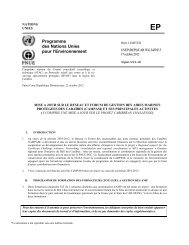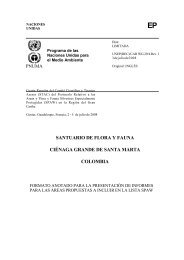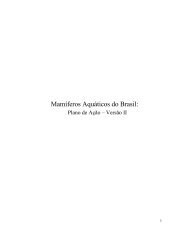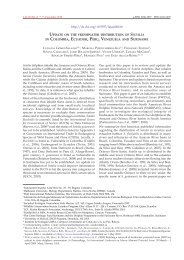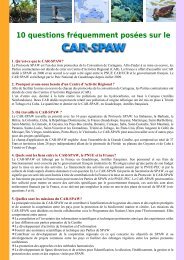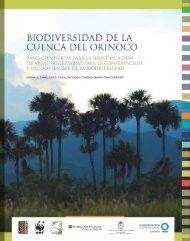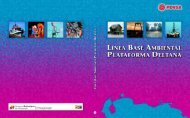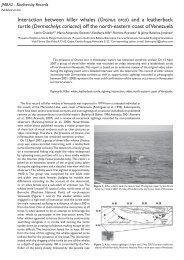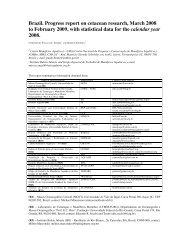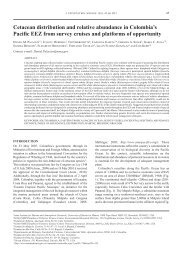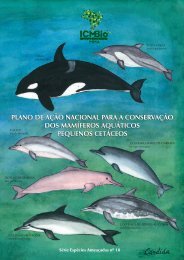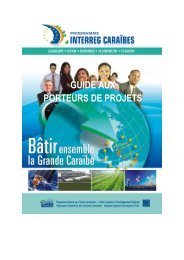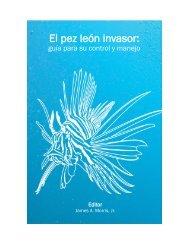1 - CAR-SPAW-RAC
1 - CAR-SPAW-RAC
1 - CAR-SPAW-RAC
You also want an ePaper? Increase the reach of your titles
YUMPU automatically turns print PDFs into web optimized ePapers that Google loves.
EXECUTIVE SUMMARYBIODIVERSIDAD DE LA CUENCA DEL ORINOCO:II. ÁREAS PRIORITARIAS PARA LA CONSERVACIÓNY USO SOSTENIBLEC. LassoC. LassoWith the information supplied by the participatinginstitutions, a map of conservation opportunities wasdrawn up for the Orinoco Basin and final conclusions weremade to guide future actions.RESULTSFive work stations were formed by the 94 participants from47 institutions of this workshop. The results of each phaseof the analysis are presented below:Threat EvaluationThe largest percentage values were assigned to deforestation,exotic species and hunting (totaling 33.6%) and the lowestvalue was assigned to climate change (8.9%).In the Orinoco Andes region special mention was madeof the effects of high human population density and itsnegative impact on biodiversity. Associated with humanpresence deforestation, habitat fragmentation, roads, waterpollution and introduction of exotic species were identifiedas threats.In the Orinoco Plains overfishing and hunting wereconsidered the principal threats along with changes inland use and deforestation. In the Guyanan-Delta region,overfishing, hunting, illegal wildlife trafficking anddeforestation were considered the principal threats tobiodiversity. In all cases, the lack of information about localbiodiversity was considered a type of threat, since it makesprediction of the behavior of ecosystems suffering impactsalmost impossible.Calculation of conservation goalsIn the Orinoco Andes 40% was estimated as the minimumconservation goal for the next two years. This value includedthe newly proposed areas as well as existing protected areas(35.2%), plus an increment of 4.8% that could be reachedthrough strategic alliances that guarantee the protection ofAndean ecosystems.In the Orinoco plains, 17% was estimated as the minimalarea needing protection. This value would include a goodrepresentation of the richly heterogeneous environmentsof this region. In the Orinoco Guyanan-Delta, theconservation goal is 30%. In the Coastal Orinoco region,a value of 2,5% was considered necessary to safeguard thebiodiversity of that region.To augment the ecosystems included in the proposalfor conservation of biodiversity in the Orinoco Basin,additional regions were included to supplement thoseidentified in 2009, adding small areas, or corridors toexisting areas. The new areas nominated in this process arethe following:Páramo corridor, including the headwaters of theGuayabero-Guaviare River, and a corridor of strategicecosystems of the Eastern Range (Parque Nacional NaturalPicachos - PNN Sumapaz - PNN Chingaza).Barinas-Canagüa corridor, which includes an altitudinalgradient from highland páramo wetlands tolowland swamps, and consists of a greenzone of 10 kmon each side of the main channel of the Canagüa River,from its origin to its junction with the Apure River.Expansion of the Casanare wetlands, which contemplatesincluding a corridor between the El Cocuy Nationalpark and two wetlands of the Arauca and Casanarerivers.Expansion of the Tuparro Biosphere Reserve, to expandthe Tuparro Biosphere towards the Tomo and Vichadarivers, and extend the buffer zone of the TuparroNational Park to include the Bita River drainage.Lipa, proposing a corridor between the upper Lipa Riverand the Arauca wetlands.Manacias, to include the origin of the Manacacias Riverand forests in the upper Manacacias drainage.Cravo Sur, to expand the Meta-Casanare corridor.Guaviare River Transitional Forests, this area wouldconnect the tropical humid forests of the Amazon withthose of the Orinoco plains.Guatopo expansion, extending the Guatopo nationalpark to the south to include important unprotectedecosystems identified in this workshop.Classification of the areas according to importance,urgency and opportunityFor the Andean Orinoco region the mining map wasconsidered to be the most urgent and important threatto regional biodiversity. In the Plains and Guyanan-Deltaregions protection of endemism and ecological connectivitywere considered the most urgent and important.Prioritizing the areasFor each of the 28 nominated conservation areas a priorityvalue was assigned, based on the analysis of importance,urgency and opportunity (19 from 2009 and 9 in 2010).This analysis showed that the areas Barinas-Canagüa, CravoSur and Isla de Mamo have the highest values accordingthe variables analyzed. However, each and every one of theproposed areas is of high value for the conservation of theBiodiversity in the binational Orinoco Basin, and representsa unique opportunity. The order of priority may facilitatedecision making, and promote synergy among groups ofscientific investigation. In any case, these 29 areas shouldbe considered reasonable and vital areas for the protectionof Orinoco biodiversity (see map).Agenda for future workHere we present the principal proposals to consolidate jointefforts in the binational Orinoco Basin.CASE STUDIESThreats and impacts to biodiversity and aquaticecosystems of the Venezuelan Orinoco BasinAquatic biodiversity depends on the quality and quantityof available water as well as the diverse dynamic historicalrelationships among living organisms. Human activitiesrepresent a threat to the ecosystems of the Orinoco River,and impacts are already visible. Dams, deforestation,agricultural fertilizers, mineral and oil extraction,navigational canals, introduced and transplanted speciesare all problems well known in this ecoregion. If thenatural hydrological and biological cycles continue to beunknown or ignored, Orinoco Basin aquatic and terrestrialecosystems will continue to destabilize. We should use theknowledge we have to decide which projects, actions anddevelopments would allow us to maintain a minimal stateof equilibrium and long term welfare.Preliminary proposal to introduce biodiversityconservation into the agroindustrial frontier ofthe Colombian Orinoco BasinThe expansion of great extensions of cultivated land, as partof the agro-industrial business in the Colombian OrinocoBasin is a land transformation factor that poses great risksfor the region and these same projects. As the accumulativeeffects accelerate, the ecological integrity of the region (orat least part of it) is seriously threatened. A design conceptfor the productive agroindustrial system that minimizesthe loss of biodiversity and maintains ecological integrityis proposed. It is based on planning procedures on a multiscaledspatial analysis and medium term time scale thatincorporates complementary administration of private andpublic lands, zoning of land use for the region, and includesnew landscapes to be incorporated into production.The central instrument to implement this is EcologicalInfrastructure planning, to support agro-ecosystemsand guarantee long term sustainability and resilience toenvironmental changes.Evaluation of the impact of shrimp trawlers onthe benthic fish community of the Orinoco RiverDeltaThe impact of shrimp trawlers on the diversity, abundance,density and biomass of benthic fishes of the OrinocoRiver Delta was evaluated during one annual hydrologicalcycle by comparing historical catch records. Shrimp trawlfishermen were accompanied the four hydrological phases.A total of 53,246 fishes were collected, belonging to 8orders and 25 families. The marine/brackish water catfishes(Ariidae) were the most abundant and accumulated thegreatest biomass. During rising water the fish biomasswas greatest; during high water the highest ratio of fishbiomass/shrimp biomass was obtained; and during lowwater the best efficiency of shrimp fishing was obtained.The family Ariidae has shown the greatest variation in theshrimp trawler fishery during the last 25 years. At the sametime, the estuarine stingrays (Dasyatidae) and the toadfish(Batrachoididae), have been the species most affected inabundance and biomass.Morichal communities in the eastern plains ofVenezuela, Colombia and Orinoco Delta: impactsof human activities on their integrity and functionThe morichal palm Mauritia flexuosa is characteristic ofswamp communities of the eastern plains of Venezuela,parts of Colombia and the Orinoco River Delta. In manystreams, the palm trees are so dense, that they form aclosed canopy. This ecosystem consists of two subunits:the terrestrial component and neighboring lotic aquaticcomponent, between which there is a constant interchangeof materials and energy upon which most of the aquatictrophic web is dependent. This system provides importantecosystem services (CO 2sink, storage, purification andregulation of subterranean water) and it is being severelyaffected by the expanding human population and increasingdemand for resources, that are brought about by changing2627



